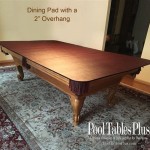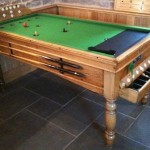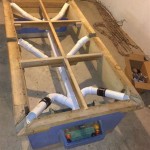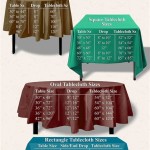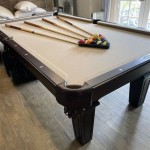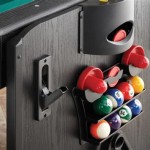Space Needed For a 7-Foot Pool Table: A Comprehensive Guide
Determining the appropriate space for a 7-foot pool table is a critical factor in ensuring a comfortable and enjoyable playing experience. A pool table requires not only the physical footprint of the table itself, but also sufficient room surrounding it to allow players to maneuver freely and execute shots without obstruction. Insufficient space can lead to awkward stances, missed shots, and an overall frustrating experience for both novice and experienced players. This article provides a detailed analysis of the space requirements for a 7-foot pool table, considering various factors that influence the optimal playing area. Understanding these requirements before purchasing and installing a pool table is essential for maximizing its functionality and enjoyment.
A 7-foot pool table, also often referred to as a bar-size table, is a popular choice for homes and recreational spaces where a full-size (8 or 9-foot) table might be too large. While smaller than its larger counterparts, it still demands a considerable amount of room to facilitate comfortable gameplay. The primary consideration is the length of the cue stick, which typically ranges from 48 to 58 inches. The surrounding space must accommodate the full stroke of the cue stick without hitting walls, furniture, or other obstructions. Additionally, the skill level of the player can affect the space needed, as less experienced players may require more room for maneuvering and recovering from off-center shots.
Calculating the Minimum Room Size
The minimum room size for a 7-foot pool table is calculated by adding the length of two cue sticks to each dimension of the table. A standard 7-foot pool table measures approximately 3.5 feet wide (42 inches) and 7 feet long (84 inches). Using a standard 58-inch cue stick, the calculation proceeds as follows:
Room width: 42 inches (table width) + 58 inches (cue stick) + 58 inches (cue stick) = 158 inches, or approximately 13.17 feet.
Room length: 84 inches (table length) + 58 inches (cue stick) + 58 inches (cue stick) = 200 inches, or approximately 16.67 feet.
Therefore, the absolute minimum room size for a 7-foot pool table, using 58-inch cues, is approximately 13.17 feet by 16.67 feet. It is important to note that this is a bare minimum and provides little to no extra room for players to move around or for any furniture within the space. This tight fit is best suited for casual players and spaces where maximizing the playing area is paramount.
Using shorter cue sticks can reduce the overall space requirement. For instance, a 48-inch cue stick would result in a smaller minimum room size. This would be calculated as follows:
Room width: 42 inches (table width) + 48 inches (cue stick) + 48 inches (cue stick) = 138 inches, or approximately 11.5 feet.
Room length: 84 inches (table length) + 48 inches (cue stick) + 48 inches (cue stick) = 180 inches, or approximately 15 feet.
In this scenario, the minimum room size would be approximately 11.5 feet by 15 feet. While seemingly significant, these reductions in space can make a substantial difference in smaller rooms, allowing for the comfortable use of a 7-foot pool table in spaces where a full-sized room would not be feasible.
Considering Playing Style and Skill Level
The playing style and skill level of the individuals using the pool table significantly influence the ideal room size. Beginner players often require more space to compensate for inaccurate shots and awkward positioning. More experienced players may be more adept at maneuvering in tighter spaces, but still benefit from ample room for executing complex shots and applying spin effectively.
Aggressive players who frequently employ jump shots or masse shots will demand even more vertical clearance. Jump shots, in particular, require a high cue angle, necessitating sufficient headroom to avoid hitting the ceiling or light fixtures. Masse shots, on the other hand, involve applying extreme spin to the cue ball, often requiring unconventional stances and greater freedom of movement.
For a more comfortable and versatile playing experience, it is advisable to add extra space beyond the bare minimum calculation. Providing an additional foot or two on each side of the table can significantly improve playability and prevent players from feeling cramped or restricted. In addition, this added space allows for the placement of spectators or additional furniture, such as seating or side tables, without encroaching on the playing area.
The presence of other individuals in the room, such as spectators or those engaged in other activities, further underscores the importance of adequate space. Even if the primary players are skilled and comfortable in a smaller space, the presence of non-players can create obstructions and distractions. Therefore, a larger room is generally preferable when multiple people are likely to be present.
Practical Considerations and Room Layout
Beyond the minimum room size calculations and playing style considerations, several practical factors influence the optimal space for a 7-foot pool table. These factors encompass the room's layout, furniture placement, lighting, and overall aesthetics. Careful planning and attention to detail can transform a cramped, awkward space into a comfortable and inviting game room.
The shape of the room is a crucial consideration. Rectangular rooms are generally preferable, as they provide a more predictable and symmetrical playing area. However, L-shaped or irregularly shaped rooms can still accommodate a pool table, provided that the playing area is situated in the most spacious and unobstructed portion of the room. In such cases, careful furniture placement is essential to avoid creating bottlenecks or interfering with gameplay.
Furniture placement plays a pivotal role in maximizing the available space and ensuring a comfortable playing environment. Avoid placing large or bulky furniture close to the pool table, as this can obstruct cue movements and limit maneuverability. Consider using smaller, more versatile pieces of furniture that can be easily moved or rearranged as needed. Seating should be strategically placed to provide comfortable viewing for spectators without impeding the players' movements.
Lighting is another critical factor to consider. Adequate and evenly distributed lighting is essential for clear visibility and accurate shot execution. Overhead lighting fixtures should be positioned to minimize shadows and glare on the playing surface. Consider using adjustable lighting that can be dimmed or brightened to suit different playing conditions and preferences. Task lighting can also be used to highlight specific areas of the table, such as the pockets or the center spot.
The flooring material can also impact the playing experience. Hardwood or tile floors are generally preferred, as they provide a stable and level surface. Carpeting, while comfortable underfoot, can sometimes interfere with cue movements and make it more difficult to maintain a consistent stance. If carpeting is used, it is important to ensure that it is low-pile and tightly woven to minimize friction and movement.
Finally, the overall aesthetics of the room should be considered. The pool table should be integrated seamlessly into the décor, creating a cohesive and inviting atmosphere. Consider using colors, textures, and accessories that complement the pool table's design and enhance the overall visual appeal of the room. A well-designed and visually appealing game room can greatly enhance the enjoyment of playing pool and create a welcoming space for family and friends.
In summary, determining the appropriate space for a 7-foot pool table involves a multifaceted evaluation of the table's dimensions, cue stick length, playing style, room layout, furniture placement, lighting, and overall aesthetics. By carefully considering these factors, individuals can create a comfortable and enjoyable playing environment that maximizes the functionality and enjoyment of their pool table.

Pool Table Room Size Calculator

Room Size Pooltables Com

Pool Table Minimum Space Requirements Room Size Snooker

How Much Room Do I Need For A Pool Table Cuesight Com

Proper Spacing For A Pool Table Home Remodeling And Improvement

Room Size Requirements Barton Mcgill

How Much Space Do I Need For A Pool Table Luxury Tables Dining Experts

Hathaway Maverick 7 Ft Pool And Table Tennis Multi Game Set With Cues Paddles Balls Bg1023 The Home Depot

Maverick 7 Ft Pool Table With Tennis Warehouse

Right Size Pool Table For Your Home Guide
Related Posts

